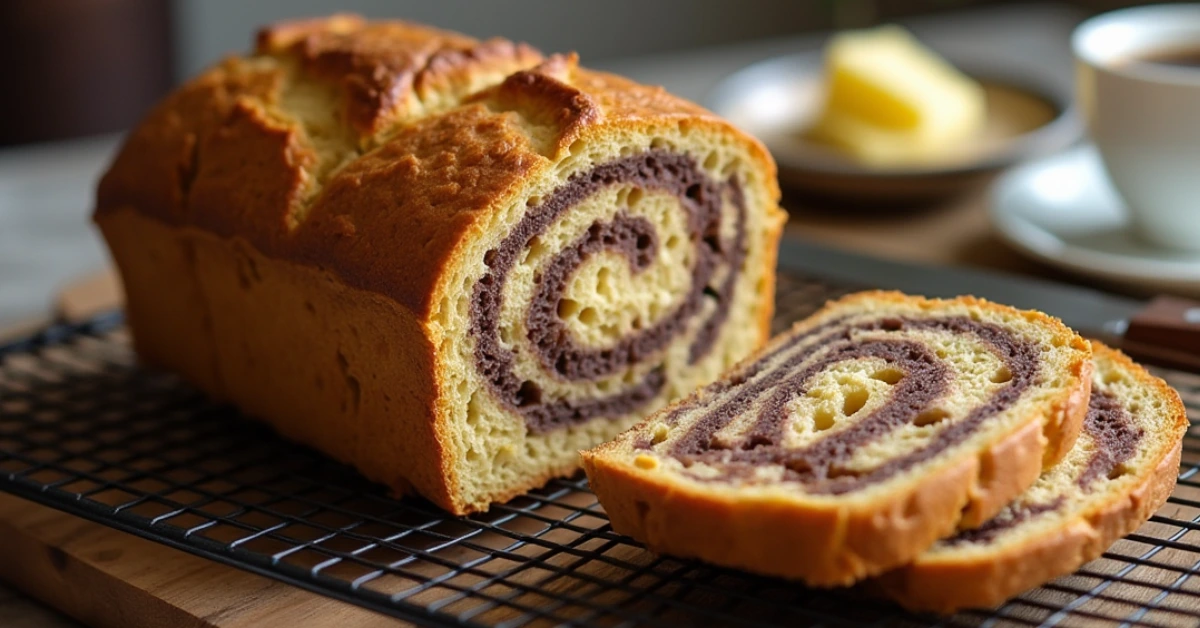Marble rye bread is a classic, visually stunning loaf that brings together the deep, earthy flavor of rye flour with the slight sweetness of molasses and the tangy depth of sourdough. If you’ve ever marveled at the beautiful swirl inside a perfect marbled rye, you might think it’s too complicated to make at home but it’s easier than you think.
With a step-by-step approach, this sourdough marble rye bread recipe ensures a soft, flavorful crumb and a crisp crust. Whether you’re making it for a Reuben, toasting it with butter, or simply enjoying it fresh, this homemade loaf will elevate your baking game.
Ready to make marble rye that’s as delicious as it is beautiful? Let’s get started.
Table of Contents
Why You’ll Love This Recipe
If you love baking bread, this marble rye bread recipe will quickly become a favorite. It’s not just about the stunning swirl this homemade loaf delivers incredible flavor and texture that store-bought versions simply can’t match. Whether you’re a seasoned baker or a beginner, this step-by-step guide makes it easy to create a rye flour masterpiece right in your kitchen.
What Makes This Recipe Special?
- Rich, complex flavor – The combination of rye flour, molasses, and sourdough starter creates a deep, slightly tangy taste that pairs well with both sweet and savory toppings.
- Soft but sturdy texture – This loaf has the perfect balance of chewiness and structure, making it ideal for sandwiches like a Reuben or simply toasted with butter.
- Visually stunning – The marbled rye effect gives this bread a bakery-quality appearance without requiring advanced baking skills.
- Naturally fermented – Thanks to the sourdough starter, this bread develops flavor through slow fermentation, improving both taste and digestibility.
Why Make It at Home?
- Control the ingredients – No preservatives or unnecessary additives, just wholesome ingredients like bread flour, cocoa powder, and caraway seeds.
- Customize the flavor – Want a bolder rye flavor? Adjust the rye flour ratio or add a bit more molasses. Prefer a lighter taste? Reduce the fermentation time.
- Enjoy the process – Baking is a rewarding experience, and this recipe gives you the confidence to knead the dough, roll the dough, and master the art of marbled rye.
Making sourdough marble rye bread at home is easier than you think. With the right ingredients and a bit of patience, you’ll bake a beautiful loaf with a classic marble rye swirl every time. Ready to get started? Let’s dive into the details.
Ingredients
To make the perfect marble rye bread, you’ll need a mix of essential baking staples and a few key ingredients that give this loaf its signature flavor and texture. Below is everything you need, along with tips to help you get the best results.
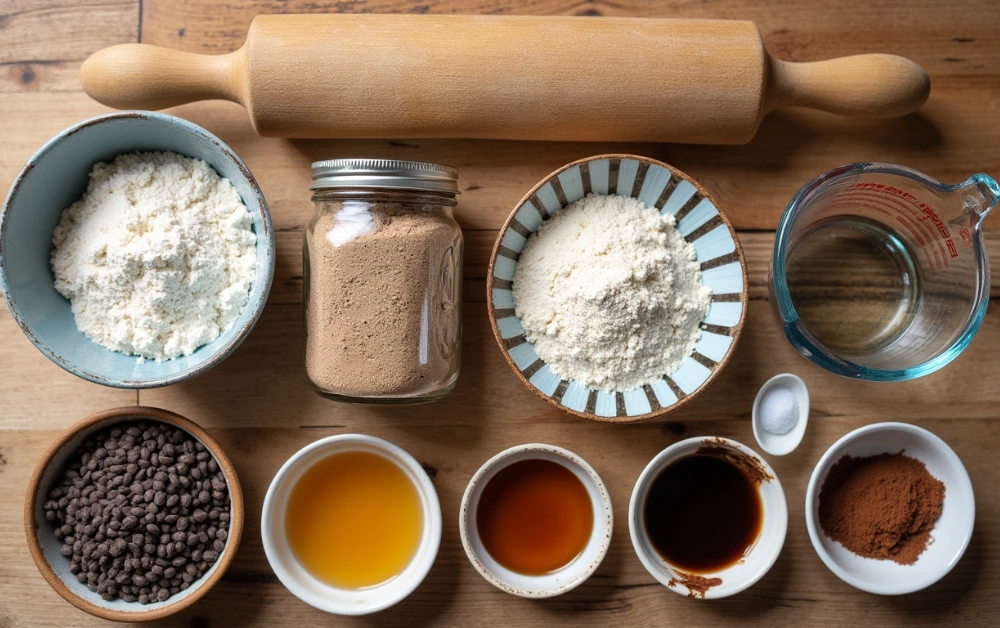
For the Dough:
- 150g sourdough starter (active and bubbly) – This gives the bread its signature tang and helps with fermentation.
- 500g warm water – Aids in gluten development and activates the starter.
- 80g honey – Adds subtle sweetness and enhances browning.
- 250g rye flour – The foundation of that bold, slightly nutty rye flavor.
- 500g bread flour – Provides structure and elasticity to the loaf.
- 10g salt – Essential for flavor balance and dough strength.
For the Dark Dough:
- 1 tbsp cocoa powder (Dutch-processed preferred) – Deepens the color without overpowering the rye flavor.
- 1 tbsp molasses (mild-flavored) – Adds richness and a hint of sweetness to balance the cocoa.
Optional Additions:
- 1 tbsp caraway seeds – For a classic, aromatic rye sourdough taste.
- Egg wash (1 egg + 1 tbsp water) – For a glossy, golden crust.
Ingredient Notes & Substitutions:
- If you prefer a more pronounced pumpernickel taste, increase the rye flour ratio.
- No sourdough starter? You can adapt this to a yeasted version by using 7g of instant yeast and reducing fermentation time.
- Molasses can be swapped for maple syrup or brown sugar if needed.
Having everything measured and ready before you start will make the process smoother. Next, let’s move on to the step-by-step marble rye bread recipe instructions!
Instructions
Making marble rye bread from scratch is a rewarding process. Follow these step-by-step instructions to achieve a perfectly balanced loaf with a stunning swirl and a rich, complex flavor.
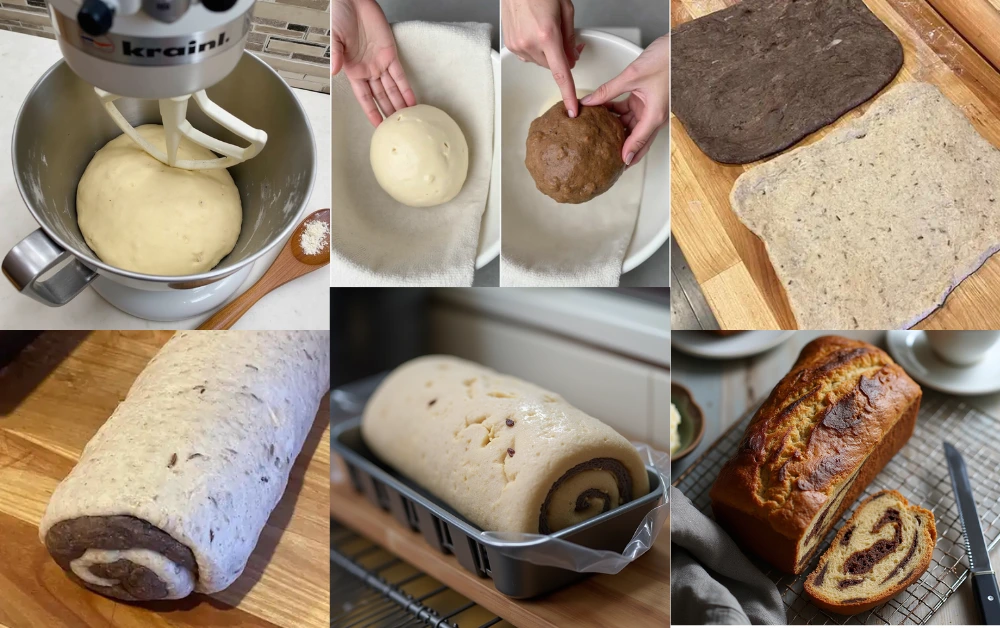
Step 1: Mix and Knead the Dough
- Lightly drizzle two mixing bowls with olive oil and set aside.
- In a stand mixer bowl (or large mixing bowl), combine:
- 150g sourdough starter
- 500g warm water
- 80g honey
- 250g rye flour
- 500g bread flour
- 10g salt
- Use a dough hook to mix on medium-low speed for 7 minutes. If kneading by hand, work the dough on a floured surface for the same amount of time. If the dough sticks, lightly wet your hands.
Step 2: Divide and Color the Dough
- Once smooth and elastic, divide the dough in half.
- Transfer one half to a prepared mixing bowl and cover with a towel.
- Place the other half back into the mixer bowl and add:
- 1 tbsp cocoa powder
- 1 tbsp molasses
- Mix until fully incorporated. This will create the darker half of the marbled rye. Transfer to the second prepared bowl and cover.
Step 3: Bulk Fermentation & Stretch and Folds (4-6 Hours)
- Let both doughs rest for 30-60 minutes.
- Perform the first set of stretch and folds:
- Grab one side of the dough, stretch it upward, then fold it over.
- Rotate 90° and repeat until all four sides have been stretched.
- Cover and let rest for 30 minutes, then repeat the stretch and folds process.
- Continue this process for 4-6 hours or until the dough has doubled in size.
Step 4: Shape the Marble Rye Swirl
- Prepare a loaf pan with parchment paper.
- On a lightly floured surface, roll the dough into two separate rectangles, each about 6×10 inches.
- Place the dark dough on top of the light dough, aligning the edges.
- Starting from the short side, roll the dough tightly into a cylinder, then pinch the seam closed.
- Turn the cylinder and roll again to create tension, ensuring a smooth, tight surface.
Step 5: Cold Fermentation (8-24 Hours)
- Place the seam side down into the loaf pan.
- Cover with plastic wrap or a towel and refrigerate overnight (at least 8 hours, up to 24). This slow fermentation enhances flavor.
Step 6: Bake the Loaf
- Preheat the oven to 425°F.
- Remove the dough from the fridge and score the top with diagonal slashes using a sharp knife.
- If available, place another loaf pan over the top to trap steam, or tent loosely with foil.
- Bake for 30 minutes covered, then remove the cover and bake another 25-30 minutes until golden brown.
- Use a thermometer to check doneness the bread is ready when it reaches 205-210°F internally.
Step 7: Cool and Enjoy
- Remove the loaf from the oven and let it cool for 30-60 minutes before slicing.
- Slice and serve fresh, or toast for an extra-crispy bite.
Now you have a beautifully baked sourdough marble rye bread with a perfect swirl and deep rye flavor! Up next, let’s explore some expert tips and variations.
Pro Tips and Variations
Mastering marble rye bread takes practice, but these tips will help you achieve the perfect loaf every time. Whether you want a bolder rye flavor, a softer texture, or a creative twist, these expert insights will guide you.
Pro Tips for Perfect Marble Rye Bread
- Use an active sourdough starter – Your sourdough starter should be bubbly and fed within 4-6 hours of baking to ensure good fermentation.
- Keep an eye on hydration – Rye flour absorbs moisture differently than bread flour, so if the dough feels dry, add a tablespoon of water at a time until it’s soft but not sticky.
- Roll the dough tightly – When shaping the marbled rye swirl, roll the dough firmly to prevent air pockets and maintain the signature pattern.
- Don’t skip the cold ferment – Refrigerating the loaf overnight enhances flavor and improves texture. The long, slow fermentation also makes it easier to digest.
- Score deeply – Shallow cuts can cause uneven expansion. Use a sharp blade to make diagonal slashes at least ¼-inch deep.
- Check doneness with a thermometer – The bread is fully baked when it reaches 205-210°F internally.
Variations to Try
- Caraway Seed Rye – Add 1 tablespoon of caraway seeds for a traditional, aromatic twist.
- Sweeter Marble Rye – Increase molasses to 2 tablespoons for a slightly sweeter, richer taste.
- Light Rye Version – Reduce the rye flour to 150g and increase bread flour for a milder flavor.
- Whole Grain Variation – Swap 50g of bread flour for whole rye or whole wheat flour for a denser, more rustic texture.
- Yeasted Alternative – If you don’t have a sourdough starter, replace it with 7g of instant yeast and reduce fermentation time to 2 hours.
If you enjoy experimenting with homemade bread, you might also like trying a Banana Nut Bread Recipe. This classic quick bread is a great way to use ripe bananas and makes a soft, flavorful loaf perfect for breakfast or snacking.
By tweaking ingredients and techniques, you can customize this sourdough marble rye bread recipe to suit your taste. Up next, let’s explore the best ways to serve and enjoy your freshly baked loaf!
Serving Suggestions
Now that you’ve baked a stunning marble rye bread, it’s time to enjoy it! This loaf is incredibly versatile, making it perfect for everything from sandwiches to simple, toasted slices. Here are some of the best ways to serve and savor your freshly baked sourdough marble rye bread.
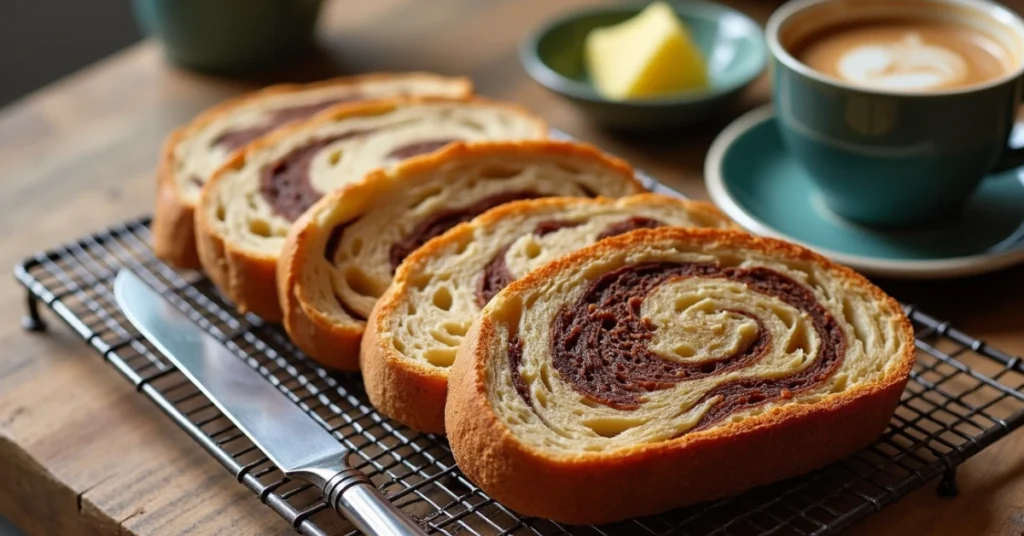
Classic Pairings
- Reuben Sandwich – The ultimate way to enjoy marbled rye! Layer corned beef, sauerkraut, Swiss cheese, and Russian dressing, then grill until golden and crispy.
- Avocado Toast – Spread mashed avocado over a toasted slice, add a sprinkle of caraway seeds, and finish with a drizzle of olive oil.
- Smoked Salmon & Cream Cheese – The tangy depth of sourdough pairs beautifully with silky smoked salmon, fresh dill, and a squeeze of lemon.
- Grilled Cheese – Swap your usual bread for marble rye and make a gooey, crispy grilled cheese sandwich with sharp cheddar or gouda.
Simple & Delicious Ideas
- Butter & Honey – A slice of warm rye sourdough with butter and a drizzle of honey highlights the bread’s natural sweetness.
- Egg & Cheese Toast – Top a toasted slice with a fried or poached egg, a sprinkle of salt, and a bit of melted cheese for a hearty breakfast.
- Soup & Bread Pairing – Serve thick slices alongside a bowl of tomato soup, potato leek soup, or classic chicken noodle for a cozy meal.
Storage & Freezing Tips
- Store at room temperature in a bread box or wrapped in a clean kitchen towel for up to 3 days.
- For longer storage, slice and freeze in an airtight bag for up to 3 months. Toast from frozen for easy, fresh-tasting bread anytime.
No matter how you serve it, this marble rye bread recipe brings bakery-quality results to your kitchen.
Conclusion
Baking marble rye bread at home is a rewarding experience that brings both flavor and artistry to your kitchen. With its beautiful swirl, rich rye flavor, and perfectly balanced texture, this loaf is as enjoyable to make as it is to eat.
By following this step-by-step guide, you’ll master the process of working with sourdough, rye flour, and bread flour to create a soft yet sturdy bread that’s ideal for everything from sandwiches to simple toast. Whether you stick to the classic recipe or try a variation, each bake will improve your skills and deepen your appreciation for homemade bread.
The beauty of sourdough marble rye bread is that it’s both a challenge and a joy a recipe that improves with practice and delivers bakery-quality results right from your own oven. So, gather your ingredients, trust the process, and enjoy every slice of your homemade marbled rye!
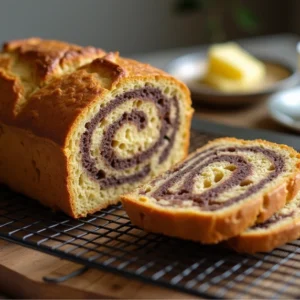
Marble Rye Bread
Ingredients
For the Dough:
- 150 g sourdough starter active and bubbly
- 500 g warm water
- 80 g honey
- 250 g rye flour
- 500 g bread flour
- 10 g salt
For the Dark Dough:
- 1 tbsp cocoa powder Dutch-processed preferred
- 1 tbsp molasses mild-flavored
Optional Additions:
- 1 tbsp caraway seeds for traditional rye flavor
- 1 egg wash 1 egg + 1 tbsp water, for a glossy crust
Instructions
Mix and Knead the Dough
- Lightly oil two mixing bowls and set aside.
- In a large bowl or stand mixer, combine:
- Sourdough starter, warm water, honey, rye flour, bread flour, and salt.
- Knead with a dough hook on medium-low for 7 minutes (or by hand for the same time).
Divide and Prepare the Dark Dough
- Divide the dough in half. Transfer one half to a prepared bowl and cover.
- Add cocoa powder and molasses to the other half. Mix until fully combined.
- Transfer the dark dough to the second bowl, cover both, and set aside.
Bulk Fermentation & Stretch and Folds (4-6 Hours)
- Let both doughs rest for 30-60 minutes.
- Perform stretch and folds every 30 minutes for 4-6 hours, or until the dough doubles in size.
Shape the Marble Rye Swirl
- Line a loaf pan with parchment paper.
- Roll both doughs into 6×10-inch rectangles on a lightly floured surface.
- Place the dark dough on top of the light dough, then roll tightly into a cylinder.
- Pinch the seam closed and roll again for extra tension.
Cold Ferment (8-24 Hours)
- Place the seam side down in the loaf pan.
- Cover with plastic wrap and refrigerate overnight.
Bake the Bread
- Preheat the oven to 425°F.
- Remove the dough from the fridge and score the top with diagonal slashes.
- Cover with a second loaf pan (or tent with foil) and bake for 30 minutes.
- Remove the cover and bake for another 25-30 minutes, until golden brown.
- The bread is ready when it reaches 205-210°F internally.
Cool and Serve
- Remove the loaf from the oven and let it cool for 30-60 minutes before slicing.
- Serve fresh, toasted, or as the base for a delicious Reuben sandwich.
Notes
- Calories: 200 kcal
- Carbohydrates: 38g
- Protein: 5g
- Fat: 2g
- Fiber: 3g
- Sugar: 3g
- Sodium: 250mg
FAQs
Is marble rye a healthy bread?
Yes! Marble rye bread is a great choice if you’re looking for a nutritious, fiber-rich bread. Thanks to rye flour, it contains more fiber and essential nutrients compared to white bread. If made with a sourdough starter, it may also be easier to digest and support gut health.
What is the difference between rye bread and marble rye bread?
Traditional rye bread is made with rye flour and sometimes a mix of bread flour for structure. Marble rye bread, on the other hand, combines both light and dark rye doughs, creating a distinct swirl that adds a mild contrast in flavor and a more striking appearance.
What does marble rye taste like?
Marble rye has a slightly tangy, nutty flavor with a subtle sweetness from molasses. The rye flour gives it a hearty, earthy depth, while the dark portion, made with cocoa powder, adds a hint of richness without tasting like chocolate.
Is it OK to eat rye bread every day?
Yes, you can enjoy rye bread daily, especially if you choose a naturally fermented sourdough marble rye bread recipe. The high fiber content in rye flour supports digestion and helps keep you full longer.
What is the dark part of marble rye?
The dark swirl in marbled rye is made by mixing the dough with cocoa powder and molasses. This enhances the color and adds a mild depth of flavor without making the bread overly sweet or bitter.
How to eat rye bread?
There are endless ways to enjoy rye bread:
As a sandwich – It’s the classic choice for a Reuben or pastrami sandwich.
Toasted with butter – A simple yet delicious way to enjoy its natural flavors.
With cheese and smoked salmon – The tangy bite of sourdough rye pairs well with savory toppings.
Dipped in soup – A great side for hearty soups like tomato, lentil, or potato leek.
Is marble rye bread high in carbs?
Yes, like most breads, marble rye contains a moderate amount of carbohydrates. However, its rye flour base provides more fiber and nutrients than white bread, making it a better option for sustained energy.
How much sugar is in marble rye bread?
The sugar content depends on the recipe. This sourdough marble rye bread recipe uses molasses and honey, but both are minimal, keeping the bread naturally low in sugar compared to commercially sweetened loaves.
Is marble rye bread sweet?
Not really. While it contains a touch of molasses and honey, marble rye bread leans more toward savory with a deep, slightly nutty flavor. The sweetness is subtle and primarily balances the rye flavor rather than making the bread taste sugary.
Now that you have all the details, it’s time to bake your own marble rye bread and enjoy every delicious slice!

